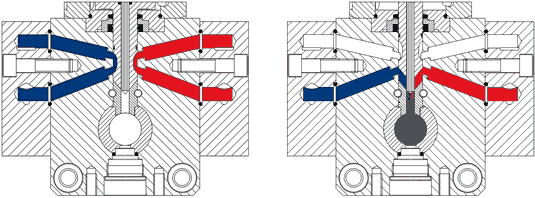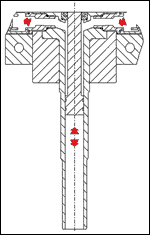'Jet-less' High-Pressure Mixhead Reduces Cost and Complexity
A radically new design for high-pressure polyurethane mixing heads is said to apply a more efficient mixing concept that requires lower pressures and thereby simplifies system design. It eliminates the usual internal jets, thereby reducing the level of operator skill needed for flow adjustments and permitting a wider range of flow rates.
The new JL (“jet-less”) family of L-shaped mixheads achieves good impingement mixing by means of speed and turbulence rather than pressure. This design eliminates the usual twin injectors for polyol and isocyanate. Instead, the two liquid components enter on opposite sides of a V-shaped feed chamber and then mix at high speed and turbulence inside a very narrow mixing chamber. The wider V-shaped feed opening requires lower initial pressure, but the flow accelerates and becomes more turbulent when it enters the tighter restriction of the narrow mixing chamber. Finally, the liquid stream enters a much longer and wider discharge duct, in which turbulence rapidly subsides into laminar flow, allowing the mix to be dispensed in a smooth stream without splashing, as with other L-shaped mixheads.
The V-shaped feed chamber is formed by the retraction of a central pin with a V-shaped front. At the end of the shot, it advances to clean out the feed chamber, while grooves on its sides allow the chemicals to recirculate.
A central needle inside the larger pin also advances at the end of the shot to clean out the mixing chamber. During the shot, the chemicals flow around the needle, which forms a variable restriction. Turning an external micrometer dial allows very fine manual adjustment of the front position of the needle, which varies the restriction and adapts it to the flow rate so as to maintain pressure in the V-shaped chamber. The needle can also be set automatically.
The discharge duct, at right angles to the mixing chamber, has its own cleaning rod, which is lubricated by a small amount of filtered and recirculated oil on each cycle. This main cleaning rod has a thicker end portion that wipes the inner surface of the duct. This wiping section of the rod is only 1 cm long; this small sliding surface reduces friction and reportedly solves problems of sticking in a long nozzle, especially with stickier formulations. The majority of the cleaning rod has a smaller diameter, reducing the weight of the head and making it easier handle manually.
SIMPLER, MORE EFFICIENT
Cannon says that computer simulations of the novel, patented design show it to be much more efficient than standard impingement mixing with jets. As a result, mixing pressure can be reduced from the usual 150 to 200 bar (2175 to 2900 psi) down to 70 to 80 bar (1015 to 1160 psi). This allows simplification of the whole metering circuit—pumps, filters, hoses, etc.—potentially reducing cost.
In addition, a wider range of flow rates (5:1 ratio from minimum to maximum) can be handled by the same size mixing chamber. And the jet-less design does not require a skilled operator to adjust the jets for flow and pressure.
Long discharge nozzle has cleaning rod with a short wiping section so as to avoid sticking. Rest of the rod shaft is thinner, making the head lighter and easier to handle. Rod is lubricated by recirculating oil (arrows at top) on each cycle.
The internal geometry of this head is also said to allow better handling of foams with high-frothing blowing agents like HFCs and pentanes. The head can accommodate fillers, too.
Finally, the long nozzle on the head is designed to reach deep into complex molds for refrigeration or panels or pipe-in-pipe tooling.
FOR FOAMS & RIM
The first JL head on the market is the model JL 24/6, with 200-mm-long discharge duct having an internal diameter of 24 mm and mixing chamber of 6 mm diam. Total output range for this head is 300 to 2000 cc/sec. It has been tested for one year at up to 60,000 shots a month.
Cannon is aiming the first JL head initially at rigid foams. Later models will address flexible foams and RIM.
Read Next
People 4.0 – How to Get Buy-In from Your Staff for Industry 4.0 Systems
Implementing a production monitoring system as the foundation of a ‘smart factory’ is about integrating people with new technology as much as it is about integrating machines and computers. Here are tips from a company that has gone through the process.
Read MoreLead the Conversation, Change the Conversation
Coverage of single-use plastics can be both misleading and demoralizing. Here are 10 tips for changing the perception of the plastics industry at your company and in your community.
Read MoreMaking the Circular Economy a Reality
Driven by brand owner demands and new worldwide legislation, the entire supply chain is working toward the shift to circularity, with some evidence the circular economy has already begun.
Read More


























